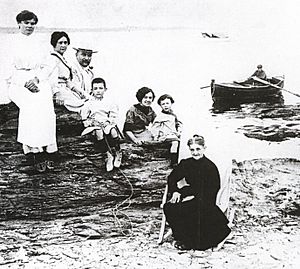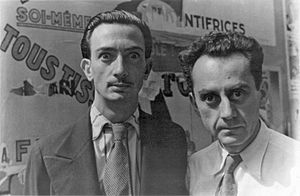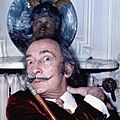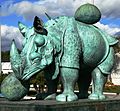Salvador Dalí facts for kids
Quick facts for kids
The Most Illustrious
Salvador Dalí, Marquess of Dalí of Púbol
|
|
|---|---|
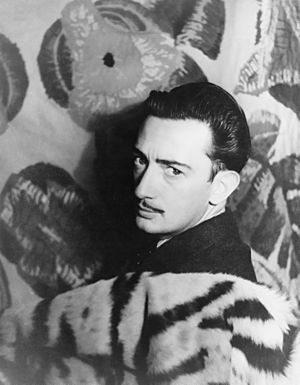
Dalí in 1939
|
|
| Born |
Salvador Domingo Felipe Jacinto Dalí i Domènech
11 May 1904 |
| Died | 23 January 1989 (aged 84) Figueres, Catalonia, Spain
|
| Resting place | Crypt at Dalí Theatre and Museum, Figueres |
| Education | San Fernando School of Fine Arts, Madrid, Spain |
| Known for | Painting, drawing, photography, sculpture, writing, film, and jewelry |
| Movement | Cubism, Dada, Surrealism |
| Spouse(s) |
Gala Dalí
(m. 1934; d. 1982) |
| Signature | |
Salvador Domingo Felipe Jacinto Dalí i Domènech, Marquis of Dalí de Púbol (11 May 1904 - 23 January 1989) was a Spanish Surrealist artist, of Catalan ethnicity, born in Figueres, Catalonia, Spain.
Born in Figueres, Catalonia, Spain, Dalí received his formal education in fine arts in Madrid. Influenced by Impressionism and the Renaissance masters from a young age he became increasingly attracted to Cubism and avant-garde movements. He moved closer to Surrealism in the late 1920s and joined the Surrealist group in 1929, soon becoming one of its leading exponents. His best-known work, The Persistence of Memory, was completed in August 1931, and is one of the most famous Surrealist paintings. Dalí lived in France throughout the Spanish Civil War (1936 to 1939) before leaving for the United States in 1940 where he achieved commercial success. He returned to Spain in 1948 where he announced his return to the Catholic faith and developed his "nuclear mysticism" style, based on his interest in classicism, mysticism, and recent scientific developments.
Dalí's artistic repertoire included painting, graphic arts, film, sculpture, design and photography, at times in collaboration with other artists. He also wrote fiction, poetry, autobiography, essays and criticism.
Dalí was highly imaginative, and also enjoyed indulging in unusual and grandiose behavior. To the dismay of those who held his work in high regard, and to the irritation of his critics, his eccentric manner and attention-grabbing public actions sometimes drew more attention than his artwork.
Dali died of heart failure in Figueras.
Contents
Biography
Salvador Dalí was born on 11 May 1904 in the town of Figueres, close to the French border in Catalonia, Spain. His father, Salvador Luca Rafael Aniceto Dalí Cusí (1872–1950) was a middle-class lawyer and notary. His mother, Felipa Domènech Ferrés (1874–1921), encouraged her son's artistic endeavors. In the summer of 1912, the family moved to the top floor of Carrer Monturiol 24 (presently 10). Dalí later attributed his "love of everything that is gilded and excessive, my passion for luxury and my love of oriental clothes" to an "Arab lineage", claiming that his ancestors were descendants of the Moors.
Dalí's older brother, who had also been named Salvador (born 12 October 1901), had died nine months earlier, on 1 August 1903. Dalí was haunted by the idea of his dead brother throughout his life. Images of his brother would reappear in his later works.
Dalí also had a sister, Anna Maria, who was three years younger. In 1949, she published a book about her brother, Dalí as Seen by His Sister.
Dalí attended the Municipal Drawing School at Figueres in 1916 and also discovered modern painting on a summer vacation trip to Cadaqués with the family of Ramon Pichot, a local artist who made regular trips to Paris. The next year, Dalí's father organized an exhibition of his charcoal drawings in their family home. He had his first public exhibition at the Municipal Theatre in Figueres in 1918, a site he would return to decades later. In early 1921 the Pichot family introduced Dalí to Futurism. That same year, Dalí's uncle Anselm Domènech, who owned a bookshop in Barcelona, supplied him with books and magazines on Cubism and contemporary art.
On 6 February 1921, Dalí's mother died of cancer. Dalí was 16 years old and later said his mother's death "was the greatest blow I had experienced in my life." After the death of Dali's mother, Dalí's father married her sister. Dalí did not resent this marriage, because he had great love and respect for his aunt.
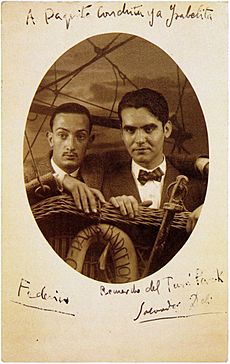
In 1922, Dalí moved into the Residencia de Estudiantes (Students' Residence) in Madrid and studied at the Real Academia de Bellas Artes de San Fernando (San Fernando Royal Academy of Fine Arts). A lean 1.72 metres (5 ft 7+3⁄4 in) tall, Dalí already drew attention as an eccentric and dandy. He had long hair and sideburns, coat, stockings, and knee-breeches in the style of English aesthetes of the late 19th century.
At the Residencia, he became close friends with Pepín Bello, Luis Buñuel, Federico García Lorca, and others associated with the Madrid avant-garde group Ultra. Dalí's friendship with Lorca was to remain one of his most emotionally intense relationships until the poet's death at the hands of Nationalist forces in 1936 at the beginning of the Spanish Civil War.
Also in 1922, he began what would become a lifelong relationship with the Prado Museum, which he felt was, 'incontestably the best museum of old paintings in the world.' Each Sunday morning, Dalí went to the Prado to study the works of the great masters. 'This was the start of a monk-like period for me, devoted entirely to solitary work: visits to the Prado, where, pencil in hand, I analyzed all of the great masterpieces, studio work, models, research.'
Those paintings by Dalí in which he experimented with Cubism earned him the most attention from his fellow students, since there were no Cubist artists in Madrid at the time.
Dalí held his first solo exhibition at Galeries Dalmau in Barcelona, from 14 to 27 November 1925. This exhibition, before his exposure to Surrealism, included twenty-two works and was a critical and commercial success.
From 1927 Dalí's work became increasingly influenced by Surrealism. Two of these works, Honey is Sweeter than Blood (1927) and Gadget and Hand (1927), were shown at the annual Autumn Salon (Saló de tardor) in Barcelona in October 1927.
Some trends in Dalí's work that would continue throughout his life were already evident in the 1920s. Dalí was influenced by many styles of art, ranging from the most academically classic, to the most cutting-edge avant-garde. His classical influences included Raphael, Bronzino, Francisco de Zurbarán, Vermeer and Velázquez. Exhibitions of his works attracted much attention and a mixture of praise and puzzled debate from critics who noted an apparent inconsistency in his work by the use of both traditional and modern techniques and motifs between works and within individual works.
Meanwhile, Dalí's relationship with his father was close to rupture. Don Salvador Dalí y Cusi strongly disapproved of his son's romance with Gala, born Elena Ivanovna Diakonova, a Russian immigrant ten years his senior, and saw his connection to the Surrealists as a bad influence on his morals. Dalí was violently thrown out of his paternal home on 28 December 1929. His father told him that he would be disinherited and that he should never set foot in Cadaqués again. The following summer, Dalí and Gala rented a small fisherman's cabin in a nearby bay at Port Lligat. He soon bought the cabin, and over the years enlarged it by buying neighboring ones, gradually building his beloved villa by the sea. Dalí's father would eventually relent and come to accept his son's companion.
Dalí and Gala, having lived together since 1929, were civilly married on 30 January 1934 in Paris. They later remarried in a Church ceremony on 8 August 1958 at Sant Martí Vell. In addition to inspiring many artworks throughout her life, Gala would act as Dalí's business manager, supporting their extravagant lifestyle while adeptly steering clear of insolvency. Dalí continued to paint her as they both aged, producing sympathetic and adoring images of her. The "tense, complex and ambiguous relationship" lasting over 50 years would later become the subject of an opera, Jo, Dalí (I, Dalí) by Catalan composer Xavier Benguerel.
The outbreak of World War II in September 1939 saw the Dalís in France. Following the German invasion, they were able to escape because on 20 June 1940 they were issued visas by Aristides de Sousa Mendes, Portuguese consul in Bordeaux, France. They crossed into Portugal and subsequently sailed on the Excambion from Lisbon to New York in August 1940. Dalí and Gala were to live in the United States for eight years, splitting their time between New York and the Monterey Peninsula, California.
The Museum of Modern Art held two major, simultaneous retrospectives of Dalí and Joan Miró from November 1941 to February 1942, Dalí being represented by forty-two paintings and sixteen drawings. Dalí's work attracted significant attention of critics and the exhibition later toured eight American cities, enhancing his reputation in America.
In October 1942, Dalí's autobiography, The Secret Life of Salvador Dalí was published simultaneously in New York and London and was reviewed widely by the press. Time magazine's reviewer called it "one of the most irresistible books of the year".
During the war years, Dalí was engaged in projects in various fields. He executed designs for a number of ballets including Labyrinth (1942), Sentimental Colloquy, Mad Tristan, and The Cafe of Chinitas (all 1944). In 1945 he created the dream sequence for Alfred Hitchcock's film Spellbound. He also produced artwork and designs for products such as perfumes, cosmetics, hosiery and ties.
In 1948, Dalí and Gala moved back into their house in Port Lligat, on the coast near Cadaqués. For the next three decades, they would spend most of their time there, spending winters in Paris and New York. Dalí's decision to live in Spain under Franco and his public support for the regime prompted outrage from many anti-Francoist artists and intellectuals. Pablo Picasso refused to mention Dalí's name or acknowledge his existence for the rest of his life.
As Dalí moved further towards embracing Catholicism he introduced more religious iconography and themes in his painting. In 1949 he painted a study for The Madonna of Port Lligat (first version, 1949) and showed it to Pope Pius XII during an audience arranged to discuss Dalí 's marriage to Gala. This work was a precursor to the phase Dalí dubbed "Nuclear Mysticism," a fusion of Einsteinian physics, classicism, and Catholic mysticism.
Dalí had been extensively using optical illusions such as double images, anamorphosis, negative space, visual puns and trompe-l'œil since his Surrealist period and this continued in his later work. At some point, Dalí had a glass floor installed in a room near his studio in Port Lligat. He made extensive use of it to study foreshortening, both from above and from below, incorporating dramatic perspectives of figures and objects into his paintings. He also experimented with the bulletist technique pointillism, enlarged half-tone dot grids and stereoscopic images. He was among the first artists to employ holography in an artistic manner. In Dalí's later years, young artists such as Andy Warhol proclaimed him an important influence on pop art.
In 1960, Dalí began work on his Theatre-Museum in his home town of Figueres. It was his largest single project and a main focus of his energy through to 1974, when it opened. He continued to make additions through the mid-1980s.
In 1968, Dalí bought a castle in Púbol for Gala, and from 1971 she would retreat there for weeks at a time, Dalí having agreed not to visit without her written permission. His fears of abandonment and estrangement from his longtime artistic muse contributed to depression and failing health.
In 1968, Dalí bought a castle in Púbol for Gala, and from 1971 she would retreat there for weeks at a time, Dalí having agreed not to visit without her written permission. His fears of abandonment and estrangement from his longtime artistic muse contributed to depression and failing health.
In 1980, at age 76, Dalí's health deteriorated sharply and he was treated for depression and Parkinson-like symptoms, including a severe tremor in his right arm.
Gala died on 10 June 1982, at the age of 87. After her death, Dalí moved from Figueres to the castle in Púbol, where she was entombed.
In 1982, King Juan Carlos bestowed on Dalí the title of Marqués de Dalí de Púbol (Marquess of Dalí of Púbol) in the nobility of Spain, Púbol being where Dalí then lived. The title was initially hereditary, but at Dalí's request was changed to life-only in 1983.
In May 1983, what was said to be Dalí's last painting, The Swallow's Tail, was revealed. The work was heavily influenced by the mathematical catastrophe theory of René Thom. However, some critics have questioned how Dalí could have executed a painting with such precision given the severe tremor in his painting arm.
In November 1988, Dalí entered hospital with heart failure. On 5 December 1988, he was visited by King Juan Carlos, who confessed that he had always been a serious devotee of Dalí. Dalí gave the king a drawing, Head of Europa, which would turn out to be Dalí's final drawing.
On the morning of 23 January 1989, Dalí died of cardiac arrest at the age of 84. He is buried in the crypt below the stage of his Theatre-Museum in Figueres. The location is across the street from the church of Sant Pere, where he had his baptism, first communion, and funeral, and is only 450 metres (1,480 ft) from the house where he was born.
The Gala-Salvador Dalí Foundation currently serves as his official estate.
Symbolism
Food
Food and eating have a central place in Dalí's thoughts and work. He associated food with beauty. Bread was a recurring image in Dalí's art, from his early work The Basket of Bread to later public performances.
The egg is another common Dalínian image. He connects the egg to hope and love. It appears in many of his works. There are also giant sculptures of eggs in various locations at Dalí's house in Port Lligat as well as at the Dalí Theatre-Museum in Figueres.
Both Dalí and his father enjoyed eating sea urchins, freshly caught in the sea near Cadaqués. The radial symmetry of the sea urchin fascinated Dalí, and he adapted its form to many artworks. Other foods also appear throughout his work.
The famous "melting watches" that appear in The Persistence of Memory suggest Einstein's theory that time is relative and not fixed. Dalí later claimed that the idea for clocks functioning symbolically in this way came to him when he was contemplating Camembert cheese.
Animals
The rhinoceros and rhinoceros horn shapes began to proliferate in Dalí's work from the mid-1950s. According to Dalí, the rhinoceros horn signifies divine geometry because it grows in a logarithmic spiral.
Various other animals appear throughout Dalí's work: donkeys and ants have been interpreted as pointing to death and locusts as a symbol of waste and fear. The elephant is also a recurring image in his work.
Science
Dalí's life-long interest in science and mathematics was often reflected in his work. His soft watches have been interpreted as references to Einstein's theory of the relativity of time and space. Images of atomic particles appeared in his work soon after the atomic bombing of Hiroshima and Nagasaki and strands of DNA appeared from the mid-1950s.
Endeavors outside painting
Dalí was a versatile artist. Some of his more popular works are sculptures and other objects, and he is also noted for his contributions to theater, fashion, and photography, among other areas.
Sculptures and other objects
From the early 1930s, Dalí was an enthusiastic proponent of the proliferation of three-dimensional Surrealist Objects. His more notable early objects include Board of Demented Associations (1930–31), Retrospective Bust of a Woman (1933) and Venus de Milo with Chest of Drawers (1936). Two of the most popular objects of the Surrealist movement were Lobster Telephone (1936) and Mae West Lips Sofa (1937) which were commissioned by art patron Edward James.
After World War II Dalí authorized many sculptures derived from his most famous works and images. In his later years other sculptures also appeared, often in large editions, whose authenticity has sometimes been questioned.
Between 1941 and 1970, Dalí created an ensemble of 39 pieces of jewelry, many of which are intricate, some containing moving parts. The most famous assemblage, The Royal Heart, is made of gold and is encrusted with 46 rubies, 42 diamonds, and four emeralds, created in such a way that the center "beats" like a heart.
Dalí ventured into industrial design in the 1970s with a 500-piece run of Suomi tableware by Timo Sarpaneva that Dalí decorated for the German Rosenthal porcelain maker's "Studio Linie". In 1969 he designed the Chupa Chups logo. He facilitated the design of the advertising campaign for the 1969 Eurovision Song Contest and created a large on-stage metal sculpture that stood at the Teatro Real in Madrid.
Theater and film
In theater, Dalí designed the scenery for Federico García Lorca's 1927 romantic play Mariana Pineda. For Bacchanale (1939), a ballet based on and set to the music of Richard Wagner's 1845 opera Tannhäuser, Dalí provided both the set design and the libretto. He executed designs for a number of other ballets including Labyrinth (1942), Sentimental Colloquy, Mad Tristan, The Cafe of Chinitas (all 1944) and The Three-Cornered Hat (1949).
Dalí became interested in film when he was young, going to the theater most Sundays. By the late 1920s he was fascinated by the potential of film to reveal "the unlimited fantasy born of things themselves" and went on to collaborate with the director Luis Buñuel on two Surrealist films: the 17-minute short Un Chien Andalou (1929) and the feature film L'Age d'Or (1930).
After he collaborated with Buñuel, Dalí worked on several unrealized film projects including a published script for a film, Babaouo (1932); a scenario for Harpo Marx called Giraffes on Horseback Salad (1937); and an abandoned dream sequence for the film Moontide (1942). In 1945 Dalí created the dream sequence in Hitchcock's Spellbound, but neither Dalí nor the director was satisfied with the result. Dalí also worked with Walt Disney and animator John Hench on the short film Destino in 1946. After initially being abandoned, the animated film was completed in 2003 by Baker Bloodworth and Walt Disney's nephew Roy E. Disney. Between 1954 and 1961 Dalí worked with photographer Robert Descharnes on The Prodigious History of the Lacemaker and the Rhinoceros, but the film was never completed.
In the 1960s Dalí worked with some directors on documentary and performance films including with Philippe Halsman on Chaos and Creation (1960), Jack Bond on Dalí in New York (1966) and Jean-Christophe Averty on Soft Self-Portrait of Salvador Dalí (1966).
Dalí collaborated with director José-Montes Baquer on the pseudo-documentary film Impressions of Upper Mongolia (1975).
In 1972 Dalí began to write the scenario for an opera-poem called Être Dieu ( To Be God). The Spanish writer Manuel Vázquez Montalbán wrote the libretto and Igor Wakhévitch the music. The opera poem was recorded in Paris in 1974 with Dalí in the role of the protagonist.
Fashion and photography
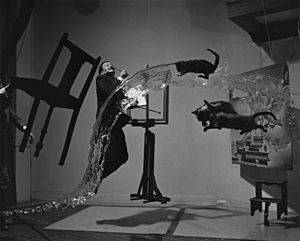
Fashion designer Elsa Schiaparelli worked with Dalí from the 1930s and commissioned him to produce a white dress with a lobster print. Other designs Dalí made for her include a shoe-shaped hat and a pink belt with lips for a buckle. He was also involved in creating textile designs and perfume bottles. In 1950, Dalí created a special "costume for the year 2045" with Christian Dior.
Photographers with whom he collaborated include Man Ray, Brassaï, Cecil Beaton, and Philippe Halsman. Halsman produced the Dalí Atomica series (1948) – inspired by Dalí's painting Leda Atomica – which in one photograph depicts "a painter's easel, three cats, a bucket of water, and Dalí himself floating in the air".
Architecture
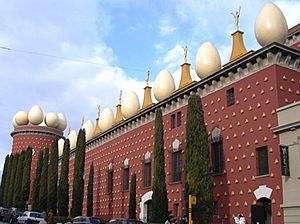
Dalí's architectural achievements include his Port Lligat house near Cadaqués, as well as his Theatre Museum in Figueres. A major work outside of Spain was the temporary Dream of Venus Surrealist pavilion at the 1939 New York World's Fair, which contained several unusual sculptures and statues, including live performers posing as statues.
Literary works
In his only novel, Hidden Faces (1944), Dalí describes the intrigues of a group of eccentric aristocrats whose extravagant lifestyle symbolizes the decadence of the 1930s. The novel was written in New York, and translated by Haakon Chevalier.
His other literary works include The Secret Life of Salvador Dalí (1942), Diary of a Genius (1966), and Oui: The Paranoid-Critical Revolution (1971). Dalí also published poetry, essays, art criticism, and a technical manual on art.
Graphic arts
Dalí worked extensively in the graphic arts, producing many drawings, etchings, and lithographs. Among the most notable of these works are forty etchings for an edition of Lautréamont's The Songs of Maldoror (1933) and eighty drypoint reworkings of Goya's Caprichos (1973–77). From the 1960s, however, Dalí would often sell the rights to images but not be involved in the print production itself. In addition, a large number of fakes were produced in the 1980s and 1990s, thus further confusing the Dalí print market.
Book illustrations were an important part of Dalí's work throughout his career. His first book illustration was for the 1924 publication of the Catalan poem Les bruixes de Llers ("The Witches of Liers") by his friend and schoolmate, poet Carles Fages de Climent. His other notable book illustrations, apart from The Songs of Maldoror, include 101 watercolors and engravings for The Divine Comedy (1960) and 100 drawings and watercolors for The Arabian Nights (1964).
Legacy
Two major museums are devoted to Dalí's work: the Dalí Theatre-Museum in Figueres, Catalonia, Spain, and the Salvador Dalí Museum in St. Petersburg, Florida, U.S.
Dalí's life and work have been an important influence on pop art, other Surrealists, and contemporary artists such as Jeff Koons and Damien Hirst. He has been portrayed on film by Robert Pattinson in Little Ashes (2008), by Adrien Brody in Midnight in Paris (2011), and by Ben Kingsley in Daliland. The Salvador Dalí Desert in Bolivia and the Dalí crater on the planet Mercury are named for him.
Honors
- 1964: Knight Grand Cross of the Order of Isabella the Catholic
- 1972: Associate member of the Royal Academy of Science, Letters and Fine Arts of Belgium
- 1978: Associate member of the Académie des Beaux-Arts of the Institut de France
- 1981: Knight Grand Cross of the Order of Charles III
- 1982: Created 1st Marquess of Dalí of Púbol, by King Juan Carlos
Dalí museums and permanent exhibitions
- Dalí Theatre-Museum – Figueres, Catalonia, Spain, holds the largest collection of Dalí's work
- Gala Dalí House-Museum – Castle of Púbol in Púbol, Catalonia, Spain
- Museo Nacional Centro de Arte Reina Sofia (Reina Sofia Museum) – Madrid, Spain, holds a significant collection
- Salvador Dalí House Museum – Port Lligat, Catalonia, Spain
- Salvador Dalí Museum – St Petersburg, Florida, contains the collection of Reynolds and Eleanor Morse, and over 1500 works by Dalí, including seven large "masterworks".
Related pages
Images for kids
-
Portrait of Dalí by Allan Warren, 1972
-
Church of Sant Pere in Figueres, site of Dalí's baptism, first communion, and funeral
-
Dalí's crypt at the Dalí Theatre-Museum in Figueres displays his name and title
-
Homage to Newton (1985), Bronze with dark patina. UOB Plaza, Singapore. Dalí's homage to Isaac Newton, with an open torso and suspended heart to indicate "open-heartedness," and an open head indicating "open-mindedness"
-
Gala in the Window (1933), Marbella
-
Perseo (Perseus), Marbella
See also
 In Spanish: Salvador Dalí para niños
In Spanish: Salvador Dalí para niños
- List of Spanish artists
- Salvador Dalí and Dance


